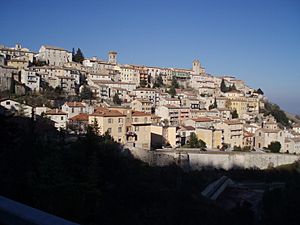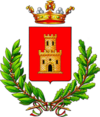Arcevia facts for kids
Quick facts for kids
Arcevia
|
||
|---|---|---|
| Città di Arcevia | ||
 |
||
|
||
| Country | Italy | |
| Region | Marche | |
| Province | Ancona (AN) | |
| Frazioni | Avacelli, Castiglioni, Caudino, Colle Aprico, Conce di Arcevia, Costa, Loretello, Magnadorsa, Montale, Monte Sant'Angelo, Nidastore, Palazzo, Piticchio, Prosano, Ripalta, San Ginesio di Arcevia, San Giovanni Battista, San Pietro in Musio, Sant'Apollinare, Santo Stefano | |
| Area | ||
| • Total | 126.25 km2 (48.75 sq mi) | |
| Elevation | 535 m (1,755 ft) | |
| Population
(30 April 2017)
|
||
| • Total | 4,518 | |
| • Density | 35.786/km2 (92.686/sq mi) | |
| Demonym(s) | Arceviesi | |
| Time zone | UTC+1 (CET) | |
| • Summer (DST) | UTC+2 (CEST) | |
| Postal code |
60011
|
|
| Dialing code | 0731 | |
| Patron saint | St. Medardus | |
| Saint day | June 8 | |
Arcevia is a charming town located in central-eastern Italy. It's part of the province of Ancona in the Marche region. Arcevia is so beautiful that it's even listed as one of "The most beautiful villages of Italy" (I Borghi più belli d'Italia).
Contents
History of Arcevia
Early Beginnings
Long ago, people believe Arcevia started as a village built by the Gauls. This was even before the Romans took over Italy. After the Romans arrived, other nearby cities like Suasa became more important than Arcevia.
Becoming an Independent Town
The town was once known as Rocca Contrada. It was made stronger with walls by Pippin the Younger, who was a King of the Franks. Later, Charlemagne gave the town to the Papal States, which were lands ruled by the Pope.
For many years, Arcevia was very important in its area. It was located where different regions met, like the Marca di Ancona, Umbria, and the Duchy of Urbino. In 1201, Rocca Contrada declared itself a commune. This meant it became independent from Rome.
In 1266, Pope Clement IV officially recognized it as a civitas, which is Latin for "city". From then on, it remained a "Guelph" city. Guelphs were groups who supported the Pope during conflicts in Italy.
Times of Conflict and Change
Rocca Contrada was known for its strong military. It often got involved in fights between local powers. In the 15th century, the town was under attack by Ladislaus, the King of Naples. The people of Rocca Contrada asked for help from a famous military leader called a condottiero, Braccio da Montone.
Braccio da Montone defeated the attackers and took back castles around Arcevia. Because of this, he was made the Signore (lord) of the city. Later, soldiers led by Francesco Sforza took over Rocca Contrada. After some more changes, the town ended up being ruled by the Guelph Malatesta family.
A Time of Growth and Art
In the 16th century, after things became more peaceful in the Papal States, Rocca Contrada really thrived. This was during the Italian Renaissance, a time of great art and learning. The city started offering classes in classic subjects. They also created groups for writers and thinkers.
Important artists were born here, like the painter Ercole Ramazzani. In the 18th century, the famous architect Andrea Vici was also born in Arcevia.
Modern History
In 1817, Pope Pius VII changed the town's name from Rocca Contrada to its current official name, Arcevia. Later, the town became part of the Kingdom of Italy. This happened when Italy was unified under the Savoy monarchy.
People from Arcevia bravely fought in both World Wars. During World War II, they resisted the Nazi occupation. Sadly, this led to a tragic event where many people lost their lives on Monte Sant'Angelo (Marche) in May 1944.
Geography and Location
Arcevia is located about 535 metres (1,755 ft) above sea level. It sits on a hill and looks over the valleys of the Misa and Nevola rivers. The town is about 50 kilometres (31 mi) southwest of Ancona. Ancona is the capital city of the province and region.
Neighboring Towns
Arcevia shares its borders with several other towns. These include Barbara, Castelleone di Suasa, Genga, Mergo, Montecarotto, Pergola, Rosora, San Lorenzo in Campo, Sassoferrato, Serra de' Conti, and Serra San Quirico.
Notable People
- Marisa Abbondanzieri (1956-) - a politician.
Twin towns
See also
 In Spanish: Arcevia para niños
In Spanish: Arcevia para niños


